|
Red Sea:
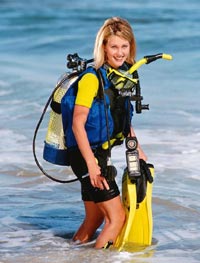 the Red Sea may seem to be a mislabeling To anyone standing on
its shore and gazing out across its heavenly waters, the Red Sea
may seem to be a mislabeling. Its blueness is eternal and
anything less red cannot be fantasized. The Red Sea, where the
desert meets the ocean, is truly one of the planet’s most exotic
and fascinating natural seascape environments. The Red Sea is
located between Asia and Africa. At its most northerly point
forms the Sinai Peninsula and stretches over 1000 miles south to
join the Indian Ocean, between Ethiopia and Yemen. In the north
and west are desert plains, while in the south a mountainous
region (2642 meters high), which is part of the mountain range
stretching from deep in Saudi Arabia, across the Sinai and then
into Nubia of the African continent. The Red Sea holds beneath
its crystal blue surface an oasis of living creatures, reefs,
and coral formation. Its use as a highway between East and West
has attracted man since the beginning of time. the Red Sea may seem to be a mislabeling To anyone standing on
its shore and gazing out across its heavenly waters, the Red Sea
may seem to be a mislabeling. Its blueness is eternal and
anything less red cannot be fantasized. The Red Sea, where the
desert meets the ocean, is truly one of the planet’s most exotic
and fascinating natural seascape environments. The Red Sea is
located between Asia and Africa. At its most northerly point
forms the Sinai Peninsula and stretches over 1000 miles south to
join the Indian Ocean, between Ethiopia and Yemen. In the north
and west are desert plains, while in the south a mountainous
region (2642 meters high), which is part of the mountain range
stretching from deep in Saudi Arabia, across the Sinai and then
into Nubia of the African continent. The Red Sea holds beneath
its crystal blue surface an oasis of living creatures, reefs,
and coral formation. Its use as a highway between East and West
has attracted man since the beginning of time.
The Red Sea was created by the movement of plates in the Earth’s
surface about 30 million years ago. In that time, the Arab
peninsula started to part from Africa along a thin break line
which was filled by the ocean’s water. However, "Mother Nature"
did not stop there. Twenty million years ago another geological
movement started. The Arab peninsula which parted from Africa,
started to move to the north. That movement struck resistance in
Turkey and swung to the east, and another break line was formed.
This one stretching all the way from the northern part of
Israel, through the Jordan valley to the Dead Sea, and finally
through the Gulf of Eilat to Ras Mohamad at the southern point
of the Sinai. The young age of the Gulf of Eilat is what makes
it so deep, 100 meters in Dahab and 1800 meters north of the
Straits of Tiran. On the other hand, the old Gulf of Suez is
relatively shallow, with a 85 meters maximum depth. The Red Sea
is still widening at about one-half inch per year, the rift is
the youngest region of continental breakup on the planet,
allowing geologists to learn about processes that occurred in
the Atlantic and Pacific oceans hundreds of millions of years
earlier.
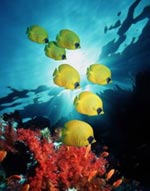
Cargo vessels, oil tankers, fishing boats, and passenger liners
all move their trade across this great waterway, but for many,
the true enchantment of the Red Sea is hidden just below its
surface. There are over 1000 species of invertebrates and around
200 recorded coral types to be found. Moreover, the Red Sea
boasts over a thousand species of fish, more species than any
other proportional body of water. Not surprisingly, therefore,
the Red Sea is considered by many to offer the very best diving
available in the marine world. The Red Sea attracts divers,
photographers, marine scientists, and leisure seekers from all
over the world, hoping to experience and explore the
incalculable wonders of the colorful, abounding marine life and
the Red Sea’s lavish coral reefs. In places, the exceptional
living reef stretches way out to sea, forming a elaborate system
of caves, lagoons, gardens, and plateaus. Some of these coral
summits plunge dramatically thousands of feet to the ocean
floor. The Red Sea is not all a delight however, as it has its
troubles which you will have to stay away from. There is minimal
danger from marine animals in the Red Sea, and with a little
common sense, even these dangers can be eliminated. Some of the
marine animals are dangerous to touch, others dangerous to eat,
and some are dangerous to come face to face with. There are fire
corals and stinging hydroids which can be extremely painful if
accidentally touched as well.
Snorkeling is a popular way to view the edge of the reef,
especially for those with limited confidence in their swimming
ability. Sharks, manta rays, turtles, and eels will take pieces
of bread from your hand, and brilliantly colored schools of fish
team all around in bewildering color. However, most divers will
tell you that there is nothing to beat the thrill of
experiencing the depth of the reef and the abounding marine life
to be found in the Red Sea. The lure of the reef is such that
many novice divers become totally "hooked" and cannot imagine
why they have never joined in the fun before. Furthermore, when
asked to compare their local diving conditions with those in the
Red Sea, they find it a "paradise" with clear visibility, little
wave action, and warm temperatures all year long.
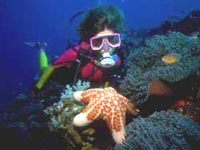
Fishing is an art which still preserves time-honored methods,
mostly due to the difficulties imposed by the dangers of the
reef. The hook-and-line method of fishing has been in use for
more than four thousand years and is still going strong.
Conservation of certain species of fish and the dangers of
over-fishing are both important issues for the government. The
fisherman land a total of 8,000 metric tons of fish per year,
which, although eight times as much as the Sudan, is less than
half Egypt’s total catch.
The water of the Red Sea is also a vital asset. Surrounding
cities are totally dependent on it for household and industrial
supplies, and tremendous desalination plants are in operation.
These supply drinking water which has been purified to a high
standard, as well as non-potable domestic water. Sea water is
also used in large quantities by oil refineries and cement works
situated along the coastline. The danger of pollution is always
present in the Red Sea, particularly from oil spillage. A Royal
Decree forbids the discharge of any pollutant substances,
including oil, within 100 miles of the Saudi Arabian coastline.
Currently, the areas of the Eastern Desert and around the Red
Sea have received a great deal of overdue attention. A joint
expedition from the University of Delaware and Leiden University
and Leiden University has been working at the ancient Red Sea
port of Berinike. The past season the Delaware-Leiden team
excavated in two areas, opened a total of seven trenches, and
found four public buildings. One of the sites contained offering
tables, an incense burner, a stela stand and an almost life-size
bronze figure of a cloaked woman clasping a snake. Scraps of
colorful textile from the Fourth and Fifth centuries A.D. have
also been found. In addition, evidence of trade appears in the
form of imported coconuts, pepper, and rice. So, while the edges
of the Red Sea are being explored, the sea itself is being
plunged in a survey of sunken wrecks. The Institute for Nautical
Archaeology in Egypt, is continuing the underwater survey
started last season, plotting the locations of shipwrecks along
the Red Sea coast.
For swimmers, divers, traders, industrialists, fishermen,
archaeologists, and tourists, the Red Sea has its own kind of
incomparability. And even the leisured gazer, speculating the
inaccessible blue/red abnormality, can be said to have been
given something to think about. The underwater amazement of the
Red Sea remains a living tapestry of resounding corals and
exotic fish, waiting for you to discover its secrets.
DIVING:
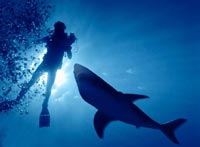 Daily Diving, Liveaboard Safari Trips, Desert Safari Diving,
Shore Diving, Wrecks, Reefs, Walls, Drifts, Diver Education and
Technical Diving... the Red Sea has it all!! Daily Diving, Liveaboard Safari Trips, Desert Safari Diving,
Shore Diving, Wrecks, Reefs, Walls, Drifts, Diver Education and
Technical Diving... the Red Sea has it all!!
If you plan on staying in a hotel but would still like to
organize a few days diving your options are endless. A
considerable range of Dive Centers offer Daily diving. This
consists of leaving by 9am, doing 2 dives, lunch and returning
around 4pm. The Red Sea boasts some of the best local diving in
the world with most sites accessible within an hours boat ride
from established diving centers.
For those who would like to dive non stop we suggest a
Liveaboard Safari trip. Most dive centers also operate
liveaboard boats and other companies specialize in this field.
These trips accommodate a range of budgets and are usually full
board with unlimited diving on more remote reefs. Mini Safaris
are available for 2-3 days, however the standard trips are for
7-14 days. At present many of the top Red Sea dive sites can
only be dived by liveaboard vessels, including the Brother
Islands, Daedelus Reef, Rocky Islands, Zabargad Island and St
Johns Reefs.
When life on a boat does not appeal there is always Shore
Diving. Many dive centers host their own house reefs or operate
shore diving excursions to nearby reefs along the coast. A
popular option is shore diving desert safaris. Most of these
operations offer rudimentary accommodation in the form of a tent
with evenings spent around the fire on the beach. When you feel
you have seen all of the shore sites, most also offer short boat
trips to nearby reefs.
There are a number of related services to be found in the Red
Sea. Shops specializing in dive equipment sales, rental and
repair. Interested in underwater photography or videography? Why
not rent an camera/video, take a photo course or simply hire a
cameraman to capture the diving highlights for you! The local
headquarters for diver training agencies such as TDI (Technical
Diving International), SSI (Scuba Schools International) and
NAUI (National Association of Underwater Instructors). The
nearest PADI (Professional Association of Diving Instructors)
headquarters exist in Europe, however most diving centers offer
PADI courses.
Bring your Dive License! Any reputable center will ask you for
one. No problem if you don't have a license; your options for
learning to dive or for advancing your education are endless.
Courses from novice all the way up to instructor level and
beyond are held regularly from a range of training agencies in
the language of your choice!
Visibility & Temperature:
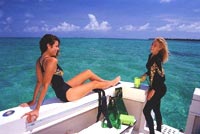 Seasonal temperature changes play a big part in determining
visibility. Winter tends to be the period of best visibility in
Northern Red Sea areas with waters too cool to support algae and
planktonic growth. Conversely, in the South, it is the Summer
which offers best visibility as the blistering hot surface
temperatures translate into sea temperatures too hot to support
the growth of marine microorganisms. No matter where you dive in
the Red Sea blooms of planktonic growth can crop up at any time
bringing the visibility down. Fortunately these are rare
occurrences and the normal visibility is excellent ranging from
10-50+ meters. Seasonal temperature changes play a big part in determining
visibility. Winter tends to be the period of best visibility in
Northern Red Sea areas with waters too cool to support algae and
planktonic growth. Conversely, in the South, it is the Summer
which offers best visibility as the blistering hot surface
temperatures translate into sea temperatures too hot to support
the growth of marine microorganisms. No matter where you dive in
the Red Sea blooms of planktonic growth can crop up at any time
bringing the visibility down. Fortunately these are rare
occurrences and the normal visibility is excellent ranging from
10-50+ meters.
Travel agents often promise water temperatures in the excess of
26°C (80°F), which is true for most of the Red Sea for much of
the year. In fact, during the peak of Summer water temperatures
often exceed 30°C. However, during the winter in the north
temperatures often fall as low as 20°C (68°F) with a surface
wind chill before and after the dive making it seem even colder.
Therefore, at least a 5mm or 7mm wetsuit is advisable for diving
the Red Sea in winter months. It is not uncommon to see a local
diveguide in a drysuit during this period, but we've gone soft
and readily accept the title of "woosie". During the summer a
lycra or 3mm suit is usually adequate.
Emergency Facilities:
Most diving centers and liveaboard vessels maintain supplies of
medical oxygen and first aid kits. Also, Sharm El Sheik, El
Gouna, Hurgahda and Marsa Alam run their own recompression
chambers
Popular diving Places: |